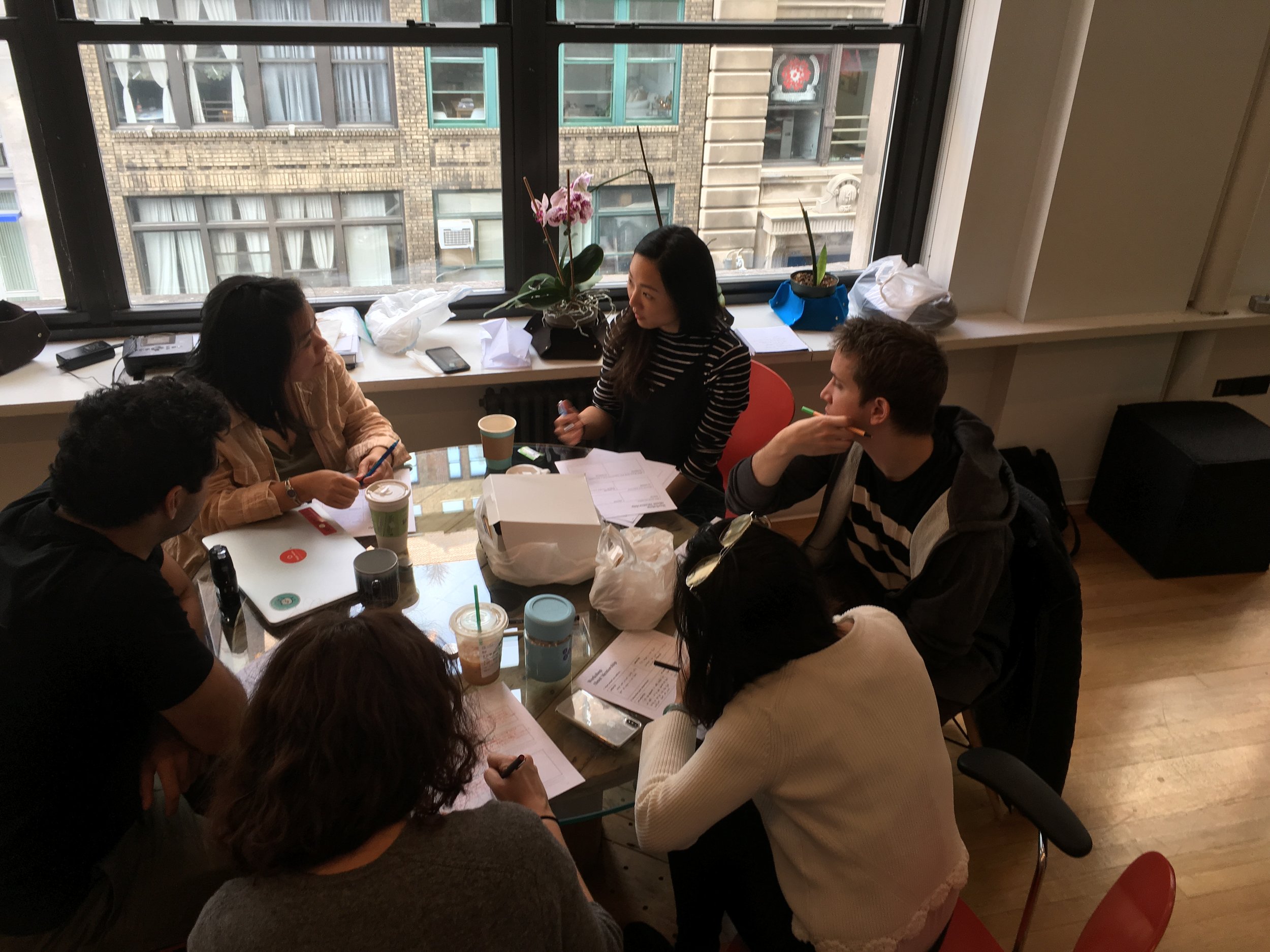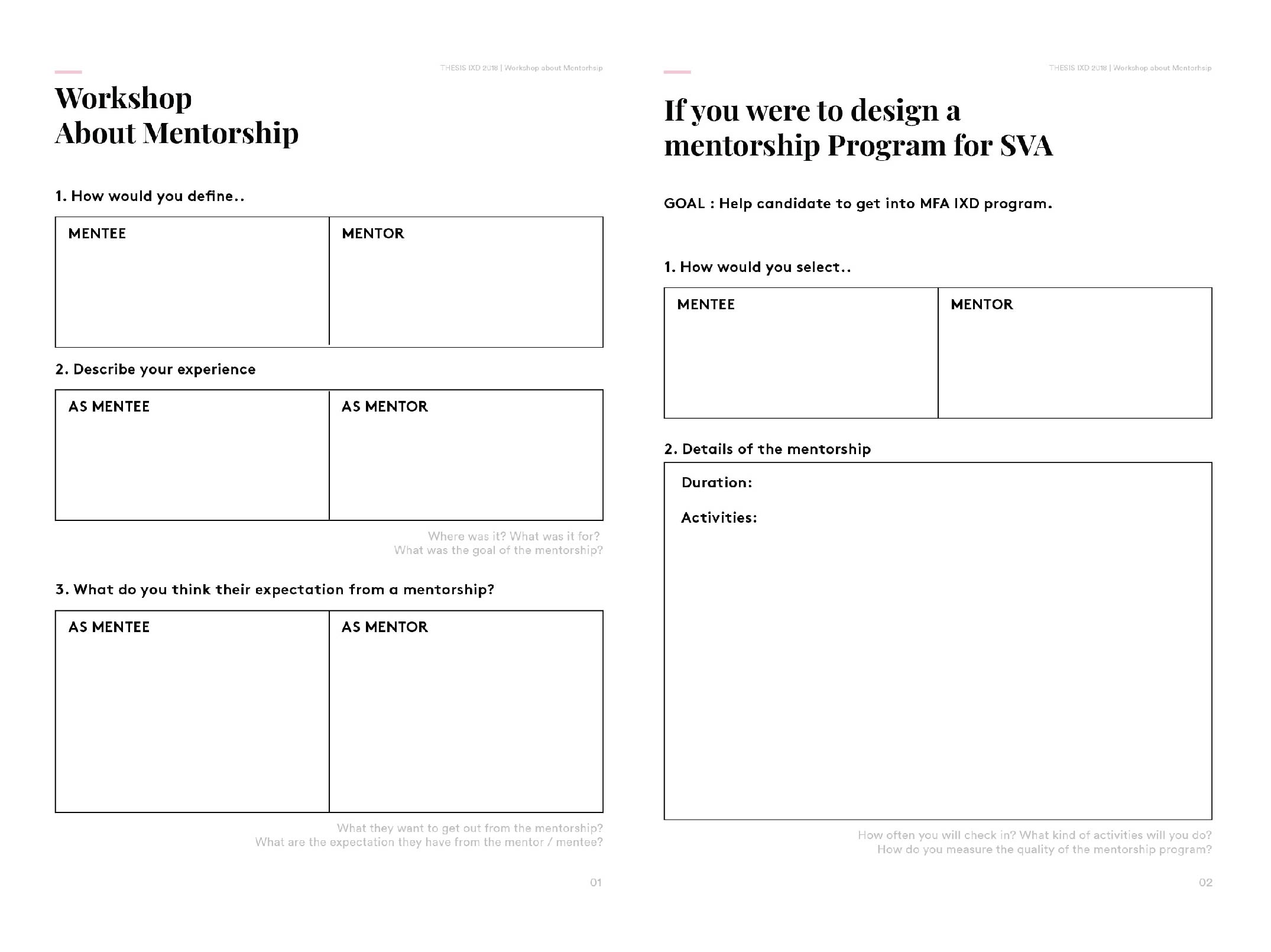Project overview
About the project
Problem: Mentorship is proven to help retain employees and foster positive working environment. However, the current mentorship programs are flawed as most programs face lack of mentors and scaling problem.
Solution: The solution proposed is a mobile app which serves as a facilitator in the mentorship. The platform is designed with a system to convert experienced mentees to become a mentor offering help to other mentees. Hence, creating a learning culture within an organization.
Timeline: This is an 8 months long project as my individual thesis project at The School of Visual Arts MFA Interaction Design Program. Instructed by Eric Forman and advised by Shalin Pei at Facebook.
My role: My role in this project focused on research, synthesizing, prototyping and final solution deliverable.
The challenge
Make Mentorship More Approachable & Accessible
Identifying the lack of mentor problems and create a platform to facilitate better mentorship experience that aimed to recruit and retain members.
The process
research
Understand "what is mentorship?"
To understand more about how mentorship is form and the process of it, I have created a small workshop with my classmates, participated in mentorship events, conduct surveys and interviewed program facilitators, mentors and mentees to understand their pain-points and the incentive of becoming a mentor.
I wanted answers to questions such as:
What is the process of a mentorship program?
What are the different roles in a mentorship?
What makes a mentorship successful?
What is the incentive for being a mentor?
Interviews
I interviewed mentors, mentees, program facilitators, Meetup founder. I also hosted a workshop to interview classmates about their mentorship experience, I found that a relationship can be formed organically and formally. For program facilitators, it is always hard to recruit mentors so some people didn't get a match and have to wait for next round. For mentee, even though there is a mentorship platform in the organization, they didn't feel like connecting with the mentors.
Online survey
I created a survey for mentor to understand their challenge during the mentorship process and their incentive of becoming a mentor. Almost all the participates mentioned about giving back to community is their biggest motivation to help others. But time and scheduling a meeting is always a challenge for them.
Competitive analysis
Understand the landscape and the different formats of mentorship on the market. for example, LinkedIn launched a feature for speed mentorship, recommend industry professionals for you to get industry insights. This is also a form of mentorship.
Mentorship experiment
I wanted to understand more about the pain-points as a facilitator. So I started a small mentorship test at my program studio. I matched 3 pairs of first year student and alumnus based on their need such as portfolio, job interviews or career path. I also created a mentorship guideline as a reference for the mentor at the beginning to guide the conversation.
My goal of this experiment :
What is the challenge as a facilitator to run a mentorship program in scale?
What motivate mentors to help people and continuing mentoring?
Problem synthesis
Mentorship System
As a mentorship program involved multiple players and stakeholders. After collecting data from different parties, I used affinity diagramming to understand the different key components in the system in order to achieve an effective mentorship.
Key for effective mentorship:
To make sure the pair is on track, it requires a lot of check-in for the facilitator which is time consuming.
The effectiveness of a mentorship relationship does not solely base on if mentee's goal is achieved.
The duration and goal relation of the program is a huge factor in determining the effectiveness of reaching the expected outcome.
Journey mapping
Identify problem areas
After understanding the system of mentorship, I created a journey map focused on the 3 main players in a mentorship program, facilitator, mentor and mentee to find out what could be the pain-points or problems for each role. I also applied cybernetic thinking to map out how a facilitator is involved in a mentorship conversation to identify the main problem area from a systemic level.
Facilitator :
Matching quality varies depends on number of mentor
Hard to coordinate with remote participates
Difficult and time consuming to check in with each pairs
Mentor :
Low incentive to participate after a period of time
Not sure if they are a good fit or helpful for the mentee
Logistic problems, scheduling meeting time
Mentee :
Not sure what they want from the mentor or the program
Lose interest or not motivate in participating over time
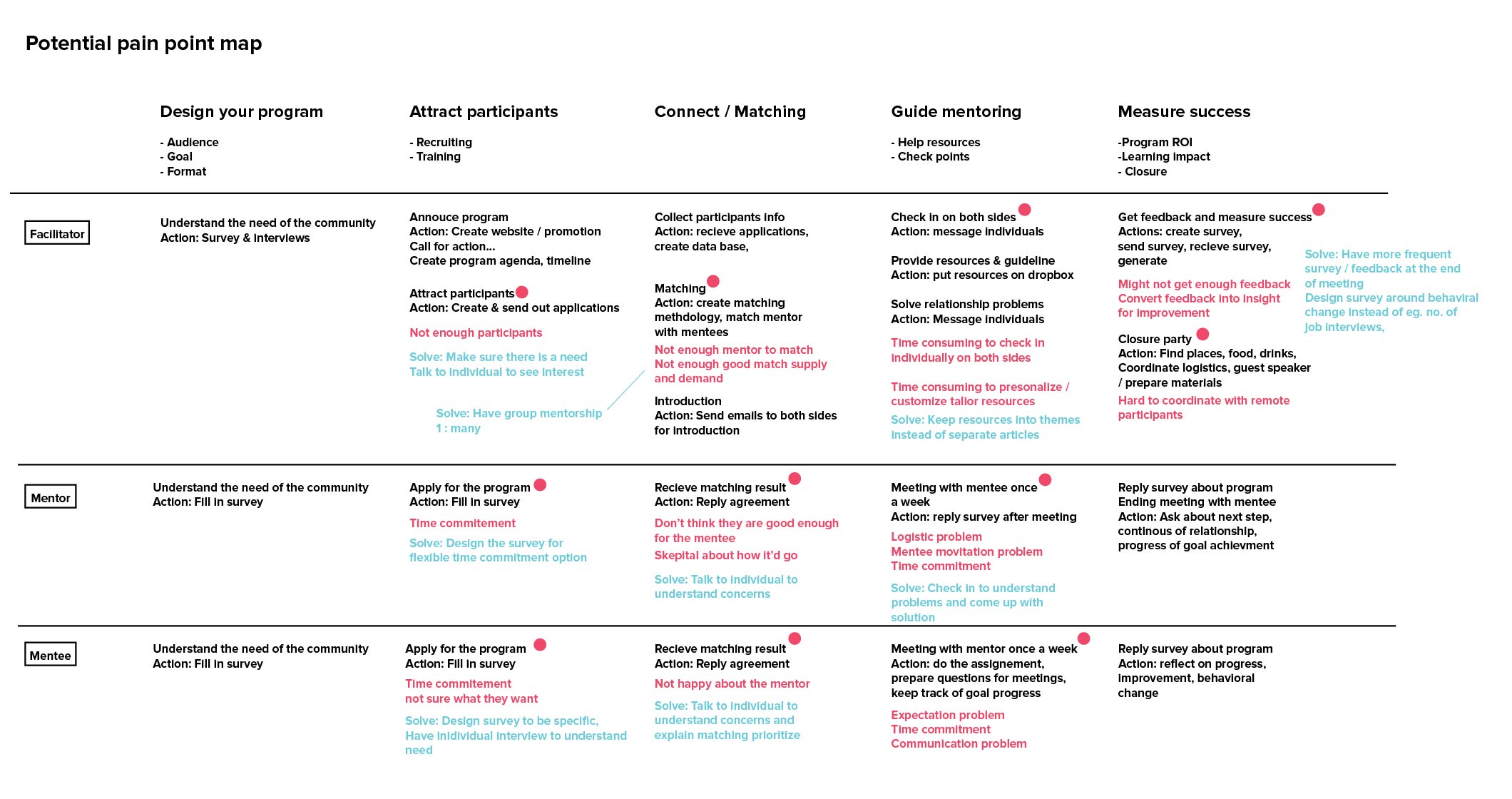
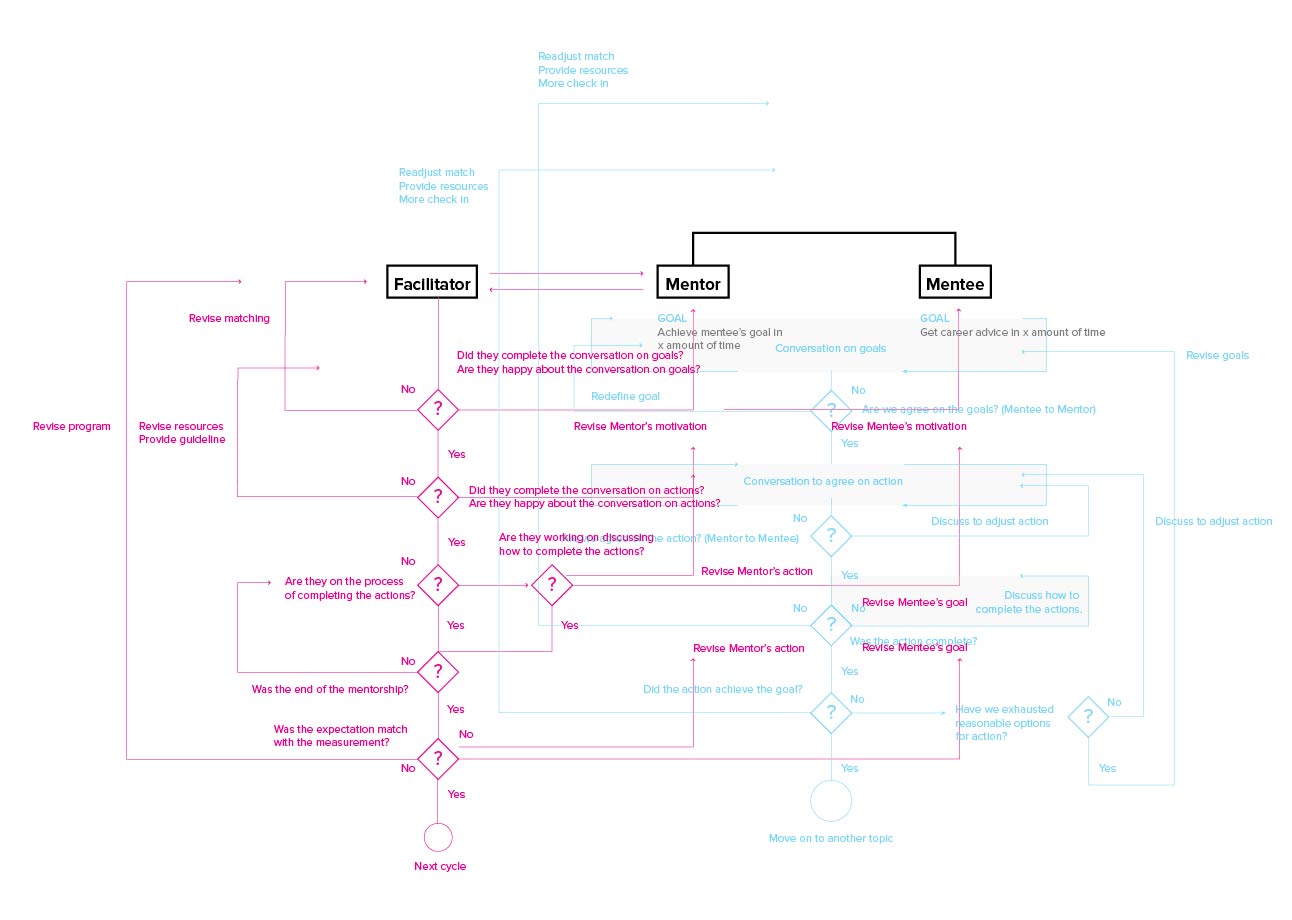

research insights
Framing the problem
Provided with the data and research, I have summarized 3 major challenges that most mentorship program faced. I decided to focus on the inventory problem, as it is also part of the matching problem.
Inventory problem
Not enough mentor on the system to match
Matching problem
Effective matching requires time investment
Facilitation problem
Hard to control quality with scale
Insight from the experiment - Mentor incentive
To solve the inventory problem is to recruit and retain mentors on the platform. So what is the incentive for people to become a mentor and how to create a better experience in order to retain them on the platform?
After interviewing and surveying focused on mentors, following are the insights on mentors incentive.
1. People need to feel equipped and connected to the person before commit to mentoring.
2. People need to know how they can provide help in different ways, sharing, connecting, providing resources, building relationship etc.
3. Mentors need validation throughout the process to know if they are being helpful.
4. The motivation for being a mentor is being able to give back to the community as they have been mentored before.
design principles
Defining strategies
After getting feedback from mentors, mentees, program facilitators and HR platform designer I have finalized 4 design principles that drive my design decision and features on the platform.
Ideation process
Sketching initial ideas
Based on the 4 insights, I found that converting mentee to become a mentor is one fundamental solution to recruit mentors on the platform. Also it is important for the mentee to feel connected to the mentor that potentially lead to a more successful mentorship; as I realized it is more effective for the mentee to drive the relationship.
I have sketched out the different cases to map out the edge cases. Edge cases like "what if I didn't get a match?", "What if I don't find the match is right for me?".
Sketches & user flow
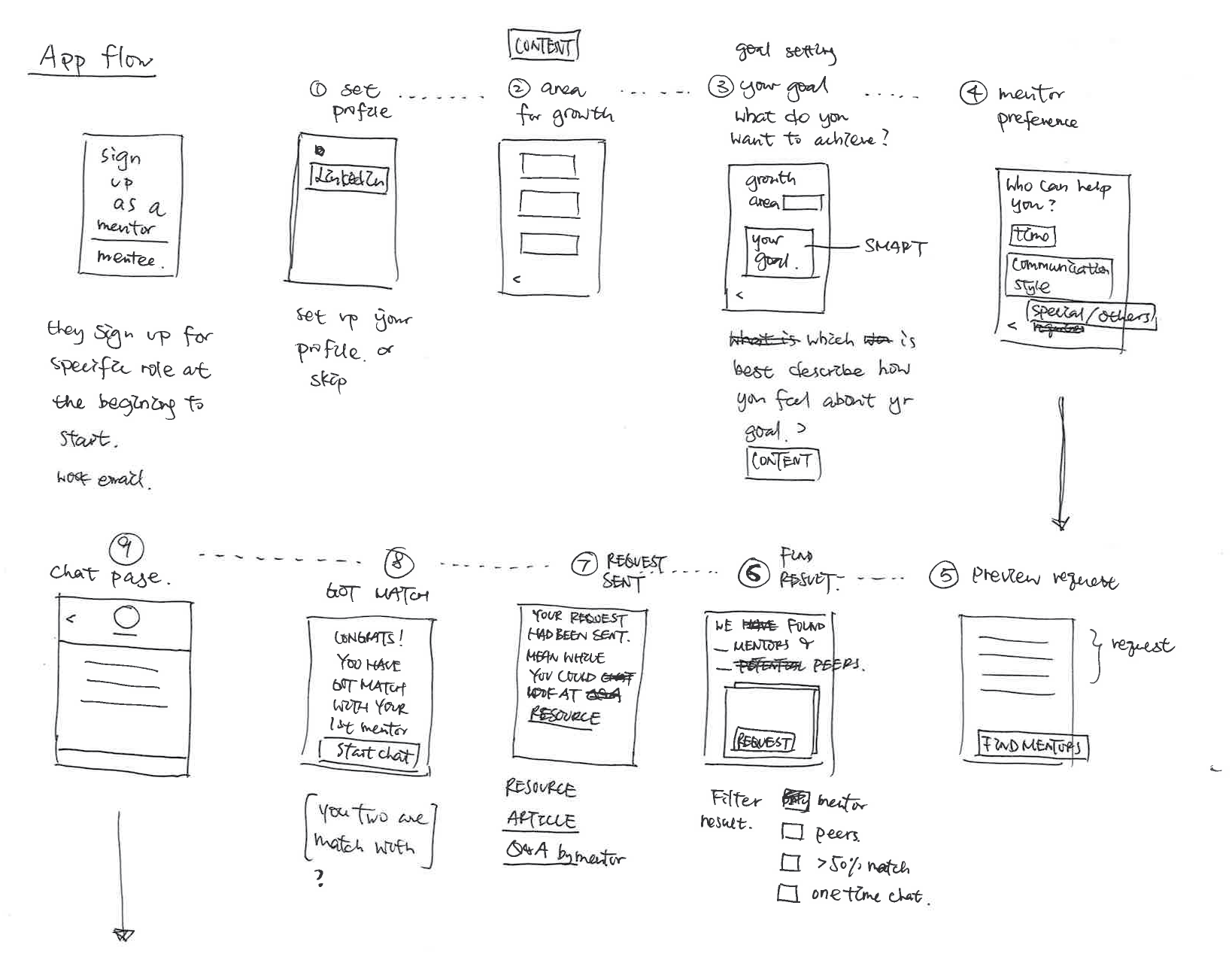
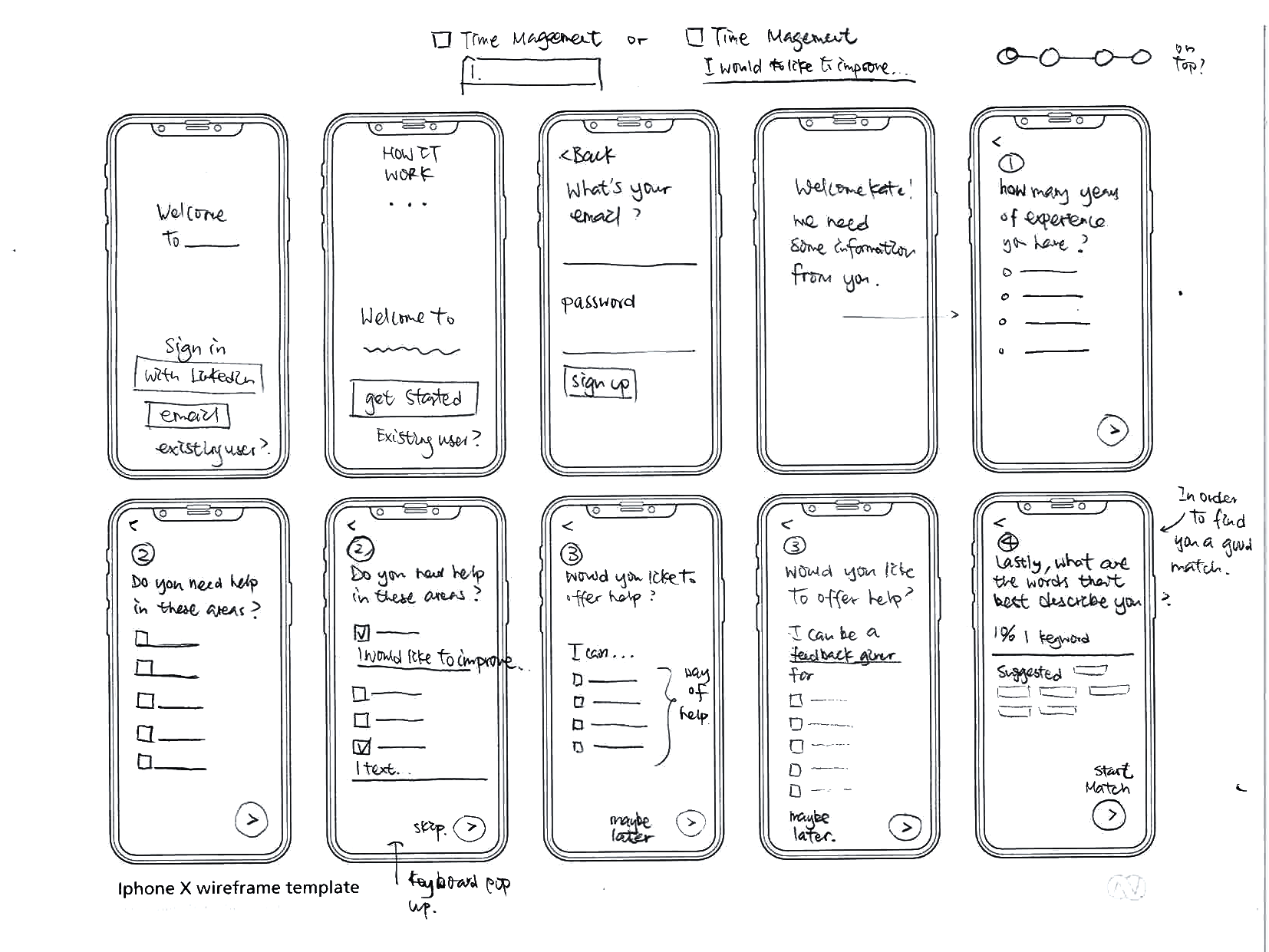
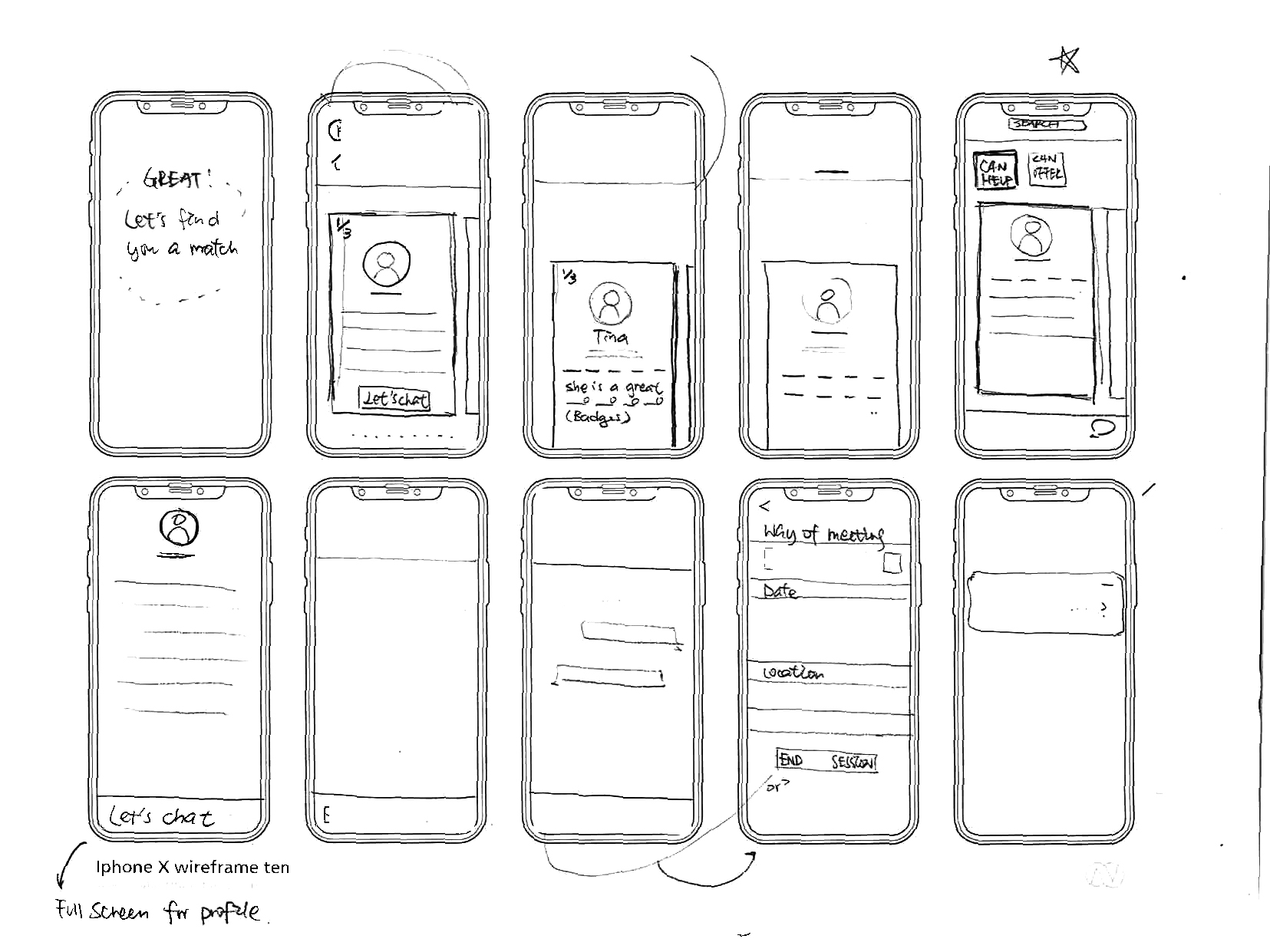


Flow Diagram
This is another way to identify if there are any edge cases and what if situations.
Identifying features
I created a feature list on Google Spreadsheet to identify which features are a must have or a nice to have. This is also important for time management of the project.
There are two key features that are crucial to achieving better matching results and recruiting mentors.
1. On-boarding: For effective matching
Like dating, mentorship also required a matching process, matching mentor and mentee. It has to be efficient and straightforward. The information should be the minimum for getting a mentor that matches the mentee's needs.
2. Conversion: Recruit new mentors
To convert a mentee to a mentor, the system has to know if that person is qualified to be a mentor in which area, which could be done at the end of the session with the mentor. If the mentor thinks that person could be a mentor, they could "nominate" her, and if she collects more than a certain number, she will be prompted to be a mentor.
Prototypes & Feedback
After finalizing the system, I created wireframes and content. I conduct user testing with peers, alumni, mentees, mentors in mentorship programs and program facilitators focused on content at the on-boarding process and the matching profile.
"I don't think I could be a mentor but with your app, I think I would be more confident to do so." - Ashley, mentee
That was one feedback that I got while testing. People need validation that they are able to help others, as the word "mentor" sound intimating to them, choosing being a mentor at the beginning would be a high friction question.
I have also shared my project with a team at Facebook working on similar product which further validated my design strategy on prompting, profile information and conversion.
the solution
Final design - Compass
Compass is a platform that connects women to make mentorship more accessible and approachable for internal organization. The platform is designed to convert experienced mentee to become potential mentor to solve the lack of mentors challenge.
Design Decisions
I have designed a "happy path" which include 6 parts. 1. On-boarding, 2. Matching, 3.Chatting, 4.End of session feedback, 5. Conversion, 6. Community. The variation and design decision of each steps are shown below.
1. On-boarding
From my research, a lot of people don't know if they can be a mentor, because the word "mentor" is intimating. My focus at the on-boarding process is choosing the right word to begin.
Things I care about when designing the on boarding flow are:
The minimum inputs for matching.
Provide flexibility in switching to different user type (mentee, mentor or members).
Encourage offering with list options (Users can choose to offer help even they need help).
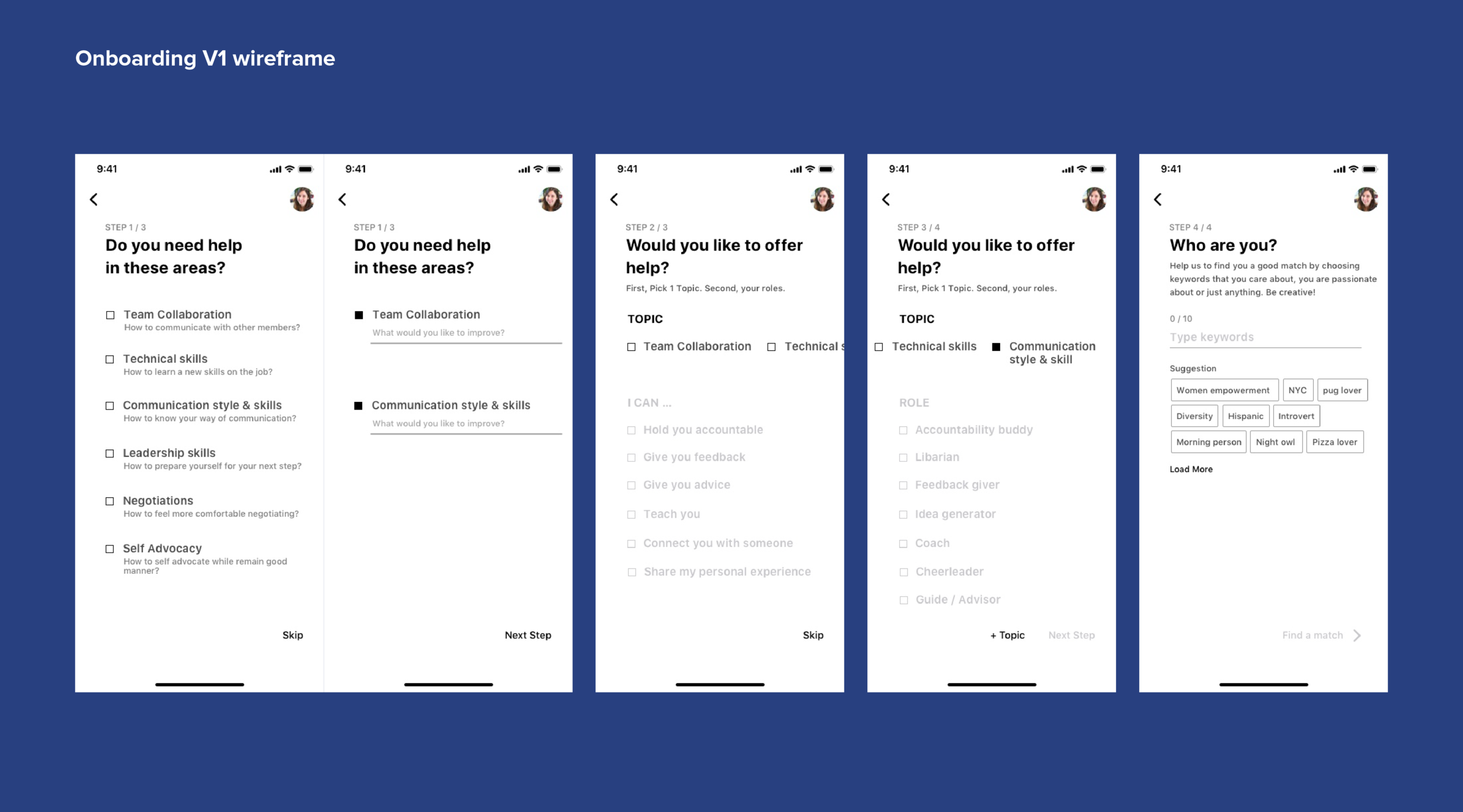

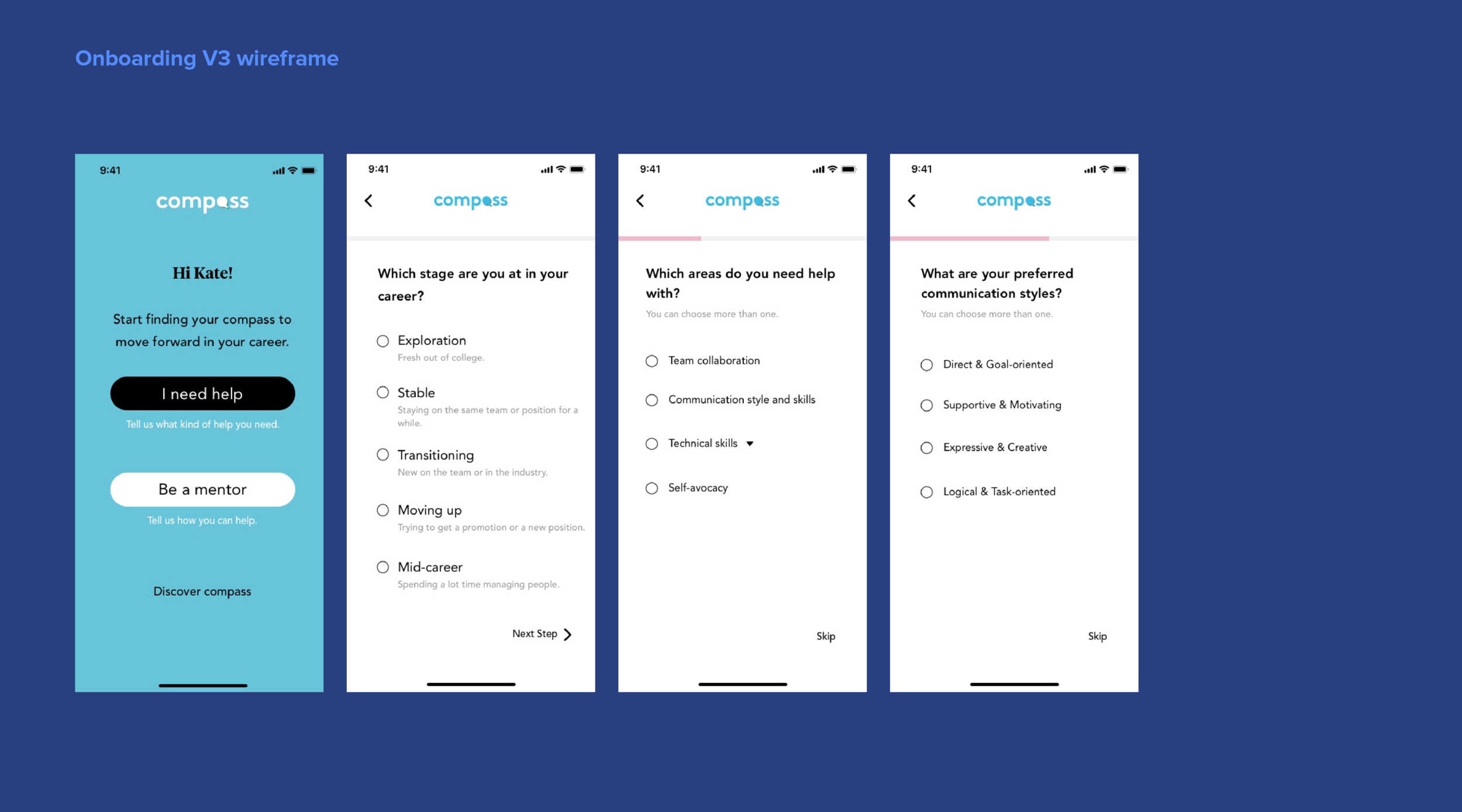

Final design
Approachable to be a mentor
Instead of making the user to choose to be a mentor or a mentee (or users that don't want to be both), using the action that users is looking for "I need help" or "I can help" is more straight-forward.
2. Matching page
From my research, a lot of existing platforms have generic information about the person, giving users a hard time to choose a person.
Things I care about when designing:
Clear information hierarchy
Shows the most important information that matters the user to find the right match effectively
Provide personal details as conversation starter or find similarity
Avoid overwhelm user with options
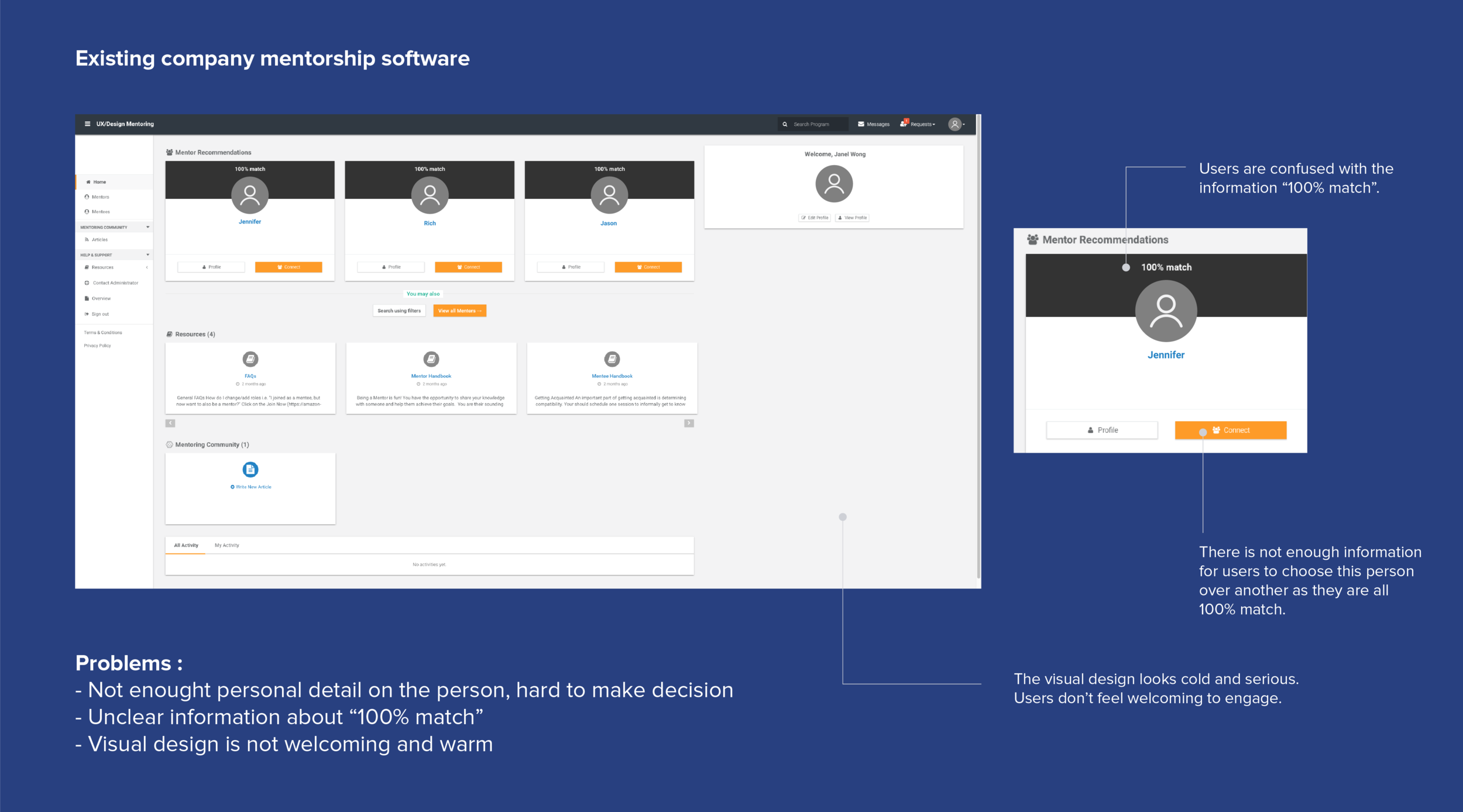


Final design
Feel connected with personal info
For Compass, the system is designed to show the right amount of information. There are only 3 options at a time and users can learn more about the person including portfolio or social media link.
3. Chatting & prompting
Light weight approach
After the first meeting, both sides will be prompted to know how the conversation goes. Having more control over the mentee could help to maintain the relationship, as they should be the one that is proactive in reaching for help. The foundation of a successful mentorship is a good relationship, so putting the initiative to continue the relationship with mentee could avoid bad matching.
Relationship building
For the mentor, the system will prompt them to have a regular check in with their mentee. Once the mentee would like to follow up, it is important to remind mentors to keep it as a regular meeting to encourage relationship building. There are different options for mentors to choose from depending on their commitment preference.
4. End of session feedback
Things I care when designing:
The feedback has to be useful for both mentor and the mentee
(Turn feedback into a review as a reference for future mentees)
Encourage positive feedback
Keep the flow simple, easy and light
4.1 End of session feedback - Mentee side
Feedback after mentoring session
From my research and the insight from the mentorship test I have found that validation of being helpful is an important incentive for mentor to continue in mentoring. They would also like to know how they are being helpful as a way to learn about themselves.
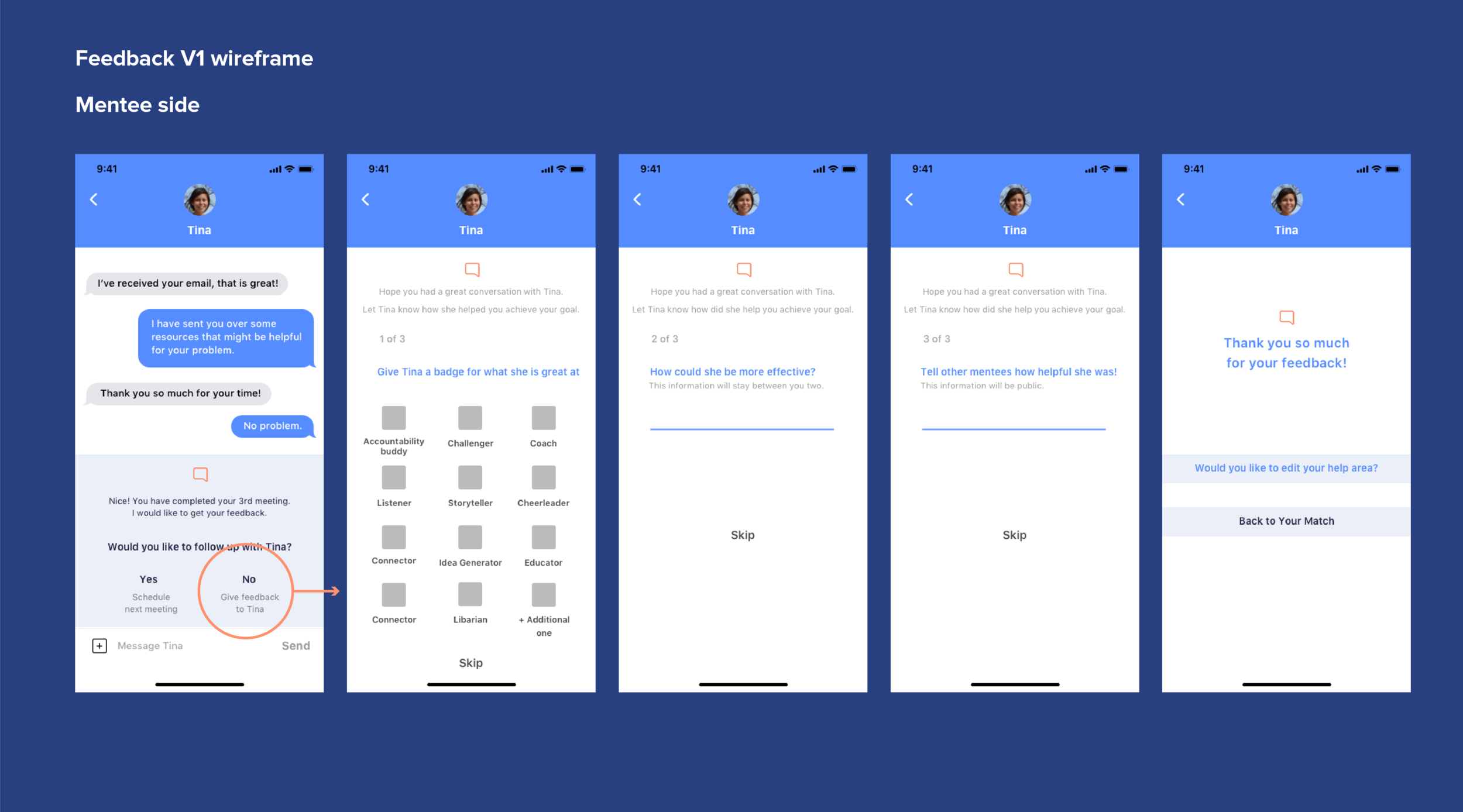
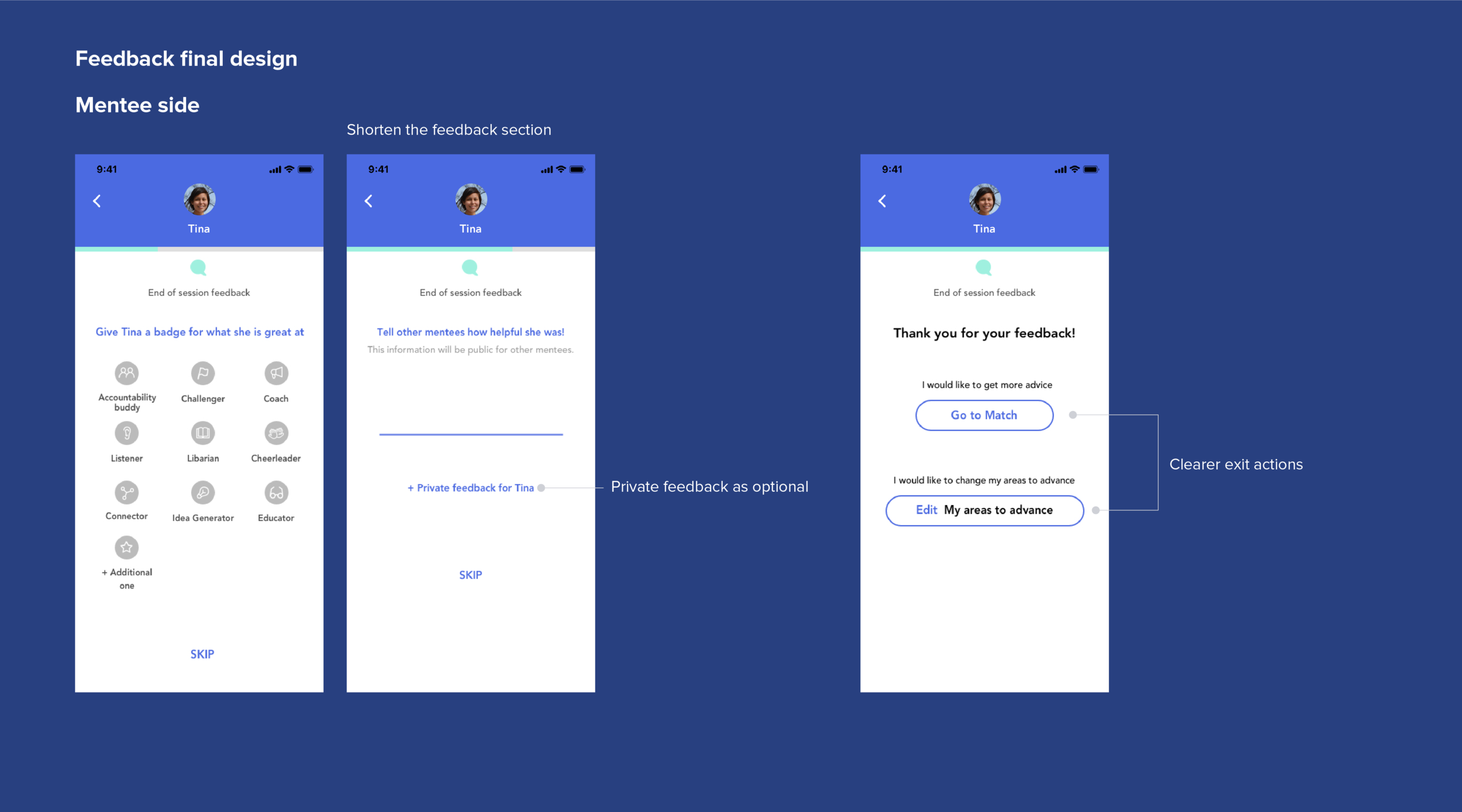
Final design - mentee side
Validation to mentor
For mentee, Kate; she will have to give feedback for Tina which include a badges, review or private feedback.
For badges: It is for the mentor to know how they are as a mentor and reflects their strength overtime.
For review: It is important information for other mentees to consider choosing their mentor.
4.2 End of session feedback - Mentor side
Recommend mentee to offer
One of the biggest insight is the incentive for mentors is giving back to the community as they have been mentored before. So the strategy is to convert experience mentee to become potential mentor.
Final design - mentor side
For the mentor, she can recommend the mentee to offer help to others for what she is great at. That could help to recruit new mentor and give validation for the mentee to start offering to others.
5. Convert mentee to mentor (Notification)
Over time, mentee will receive recommendations for beginning offering help to others. The notification is to prompt user to change their setting on the system in order to match the right person to help.
Things I care about when designing :
A clear call to action for next step ( start offering )
Voice and tone should be encouraging, optimistic and exciting
The recommendation should be anonymous
A reward system to keep user on the platform
Final design
After the mentee has received a certain number of recommendation, the system will prompt her to begin offering to others.
The system will then match her with people that need help with the area that she is has been recommended.
6. Community page
More ways to recruit mentors
There are two main reasons that people are hesitate to be a mentor, time commitment and knowing that they can help others. To solve that, a community platform not only help retaining and engage users, but also a way to provide a lighter time commitment to help by answering questions. User can also get validation from the number of "upvote" they've got from their answers which engage them to mentor others.
Final design
For the community section, it provides different options in topics and time commitment for users to contribute to the platform, including Q&A or events.
The Q&A could also be a way to prompt user to become a mentor if they received a number of "upvote" or "like" from other members that their answers are helpful. Gives validation to users that they are being helpful which motivates them to become a mentor in that area.
conclusion
Next step
Because of the time limitation, I focused on the experience of employees and the conversion strategy. In the future, I would like to understand how an organization (HR department) will use this platform to track employees performance and get insights on providing the right resources for creating a better working experience.
My learning
I am excited to work on a problem that I care about. I had a great experience collaborating with my advisor who has a great understanding of the problem in mentorship programs. I learned that it is better to focus on one problem and design the solution in solving that one problem. If there is a problem that involved a lot of stakeholders, it is important to understand the problem from a systemic perspective.
Thank you for reading.
This project will be presenting at the SVA IXD Thesis Festival as an opening project.
View next project - Jobscan Homepage Redesign



